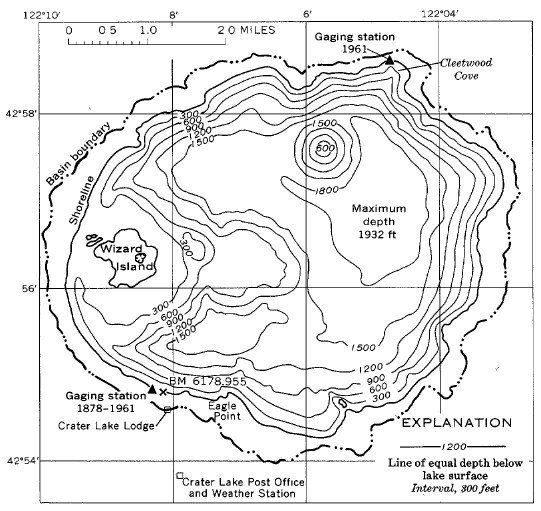 |
| FIGURE 3.-Bathymetric chart of Crater Lake. |
A study of the hydrologic regimen of Crater Lake calls for a brief review of the volcanic history leading to formation of the lake. Mount Mazama is the remnant of an extinct volcano that was active during Pleistocene and Holocene time (Williams, 1957, p. 14) and was formed of alternating effusive lava flows and layers of ejecta from explosive eruptions. The volcanic cone attained an estimated height of more than 12,000 feet. During periods of quiescence, glaciers coursed down its slopes and carved U-shaped valleys and left trains of glacial till that locally were covered by material from later eruptions. Within the body of the volcano, dike-forming masses of molten lava at times forced their way upward along planes of weakness and served as feeders for effusive flows that appeared on the slopes of the volcano. Subsidiary cinder cones also developed, especially in the area north of the main volcano. Some of the explosive eruptions threw out masses of incandescent ash that flowed as glowing avalanches for many miles down the slopes of the mountain; these materials subsequently cooled and became fused. These fused deposits are now exposed as spectacular pinnacles in the canyons eroded by some streams, notably Annie Creek and Sand Creek, that flow down the slopes of Mount Mazama.
The volume of material thrown out during the late, explosive stages of the eruption has been estimated as 17 cubic miles as deposited (Williams, 1953, p. 49). Most of the material ejected was pumice and ash that now oover about 5,000 square miles to a depth of more than 6 inches. Most of the pumice was carried by the southwest wind and deposited to the east and northeast. The explosive emptying of the magma chamber finally removed the support from the upper-central part of the volcano and allowed the upper part to collapse into the empty chamber. The broad crater formed by the collapse is the spectacular caldera now occupied by Crater Lake.
The pumice explosions occurred about 6,600 years ago, as shown by carbon-14 dating of 10 specimens of carbonized wood taken from the beds of pumice (Fryxell, 1965, p. 1288).
Some volcanic activity continued after the caldera was formed; the blocky lava flows on Wizard Island, apparently formed in a sub-aerial environment, may be only about a thousand years old (Williams, 1953, p. 49).
All evidence indicates that Crater Lake itself is young. The lake has no well-developed beach lines in the range of observed water levels. A water body must have begun to form soon after active volcanism ceased. The floor of the crater is probably underlain by lava flows somewhat less permeable than the volcanic ejecta of the caldera walls. Given a climate like the present one, the new lake would have increased in depth rapidly until it reached a level at which its annual supply was substantially balanced by leakage and evaporation.
The oldest trees on Wizard Island are about 900 years old (Williams, 1942, p. 94), and these trees may have been among the first to have grown on the island. The climate during that time, at least, must have been generally similar to that of the present.

